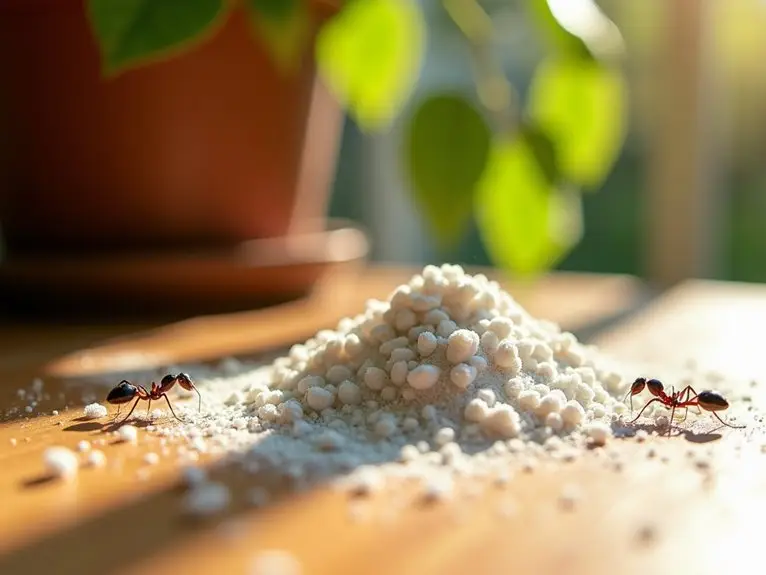Borates, like Borax, are an excellent natural solution for controlling ants effectively. To use it, mix one part borax with three parts sugar to create a bait that attracts the ants. The ants will take the mixture back to their colonies, where it disrupts their digestive systems and targets the queen. You can apply this bait indoors near trails and outdoors at ant mounds. Just make sure it’s out of reach of pets and kids. This method’s slow-acting nature means long-term effectiveness against infestations. Curious about more ways to enhance your ant control strategy?
Key Insights
- Borax, a natural mineral, effectively disrupts ant digestive systems, leading to colony eradication through gradual exposure.
- Combine borax with sugar or sweeteners in a bait to attract ants, enhancing its efficacy.
- Use small containers for bait placement, ensuring they are out of reach of children and pets for safety.
- Borax is eco-friendly but poses some risks; handle with care to prevent irritation or respiratory issues.
- Monitor ant activity and adjust bait formulations as needed for optimal results against diverse ant species.
Understanding Borax
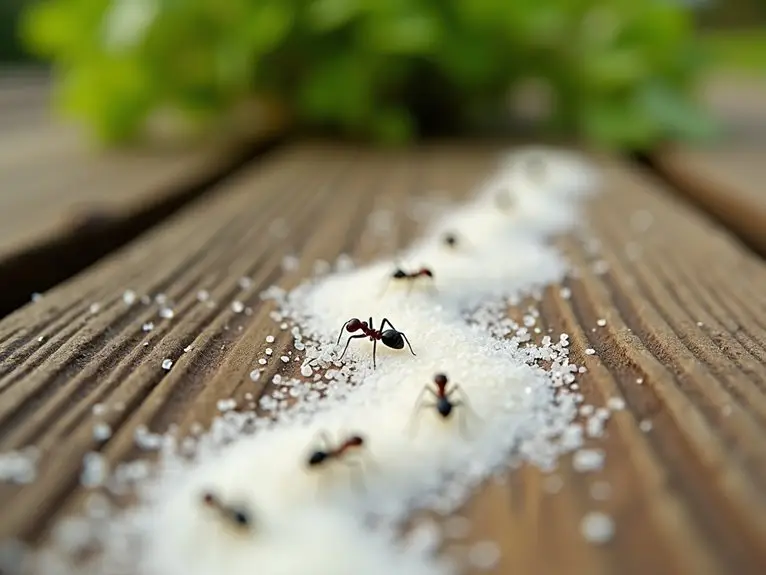
When it comes to understanding borax, it’s essential to grasp its chemical composition and properties. Borax, with the chemical formula Na₂B₄O₇·10H₂O, is a naturally occurring mineral that comes as a decahydrate. This means it contains ten water molecules, giving it a molar mass of 381.38 g/mol. Its density is about 1.73 g/cm³, which makes it a relatively lightweight substance.
When you heat borax, it melts at 75°C, but if you’re dealing with the anhydrous form, it has a much higher melting point of 743°C and a boiling point of 1575°C. Borax is also known for its anti-fungal properties, making it effective in treating certain skin conditions. Additionally, it plays a crucial role in pest control services offered by professionals to help manage infestations.
Beyond its basic properties, borax has various industrial and commercial applications. You’ll find it in detergents, laundry boosters, and even in the production of glass and ceramics. It’s also a critical component in enamel glazes and serves as a flux in metallurgy, showcasing its versatility.
In terms of security, it’s important to handle borax carefully. Classified as moderately acutely toxic by the EPA, it can cause respiratory irritation and other health issues if not treated with caution. Always store it securely and out of reach of kids.
Understanding borax is key if you’re looking for a natural solution to common problems, like pest control. Its unique properties make it a valuable ally in your quest for effective, eco-friendly solutions.
Preparing the Borax Mixture
To effectively prepare a borax mixture for ant control, you’ll need just a few simple ingredients: borax, a sweetener, and water.
Start with a common ratio of 1 part borax to 3 parts sugar or sweetener. You can use regular sugar, honey, maple syrup, or even powdered sugar. This sweetener will attract the ants, making your bait more effective. Notably, many users have reported significant reductions in ant populations within a week when using this effective solution.
For a solid bait, mix 1/4 cup of borax with 3/4 cup of powdered sugar. If you prefer a liquid bait, dissolve borax in warm syrup or honey. Confirm that the borax is fully dissolved, as this guarantees the ants receive the toxic effect without any clumps.
Once combined, you can apply this mixture on plastic wrap or cotton balls to make it easier for ants to access.
Creating the bait form is simple. For liquid bait, just mix the borax with your chosen sweet liquid until well combined. For solid bait, you might need to create a thick paste.
Ensure you’re using small containers like tin foil boats or plastic bottle caps to hold the bait, as this makes cleanup easier.
Applying Borax Indoors
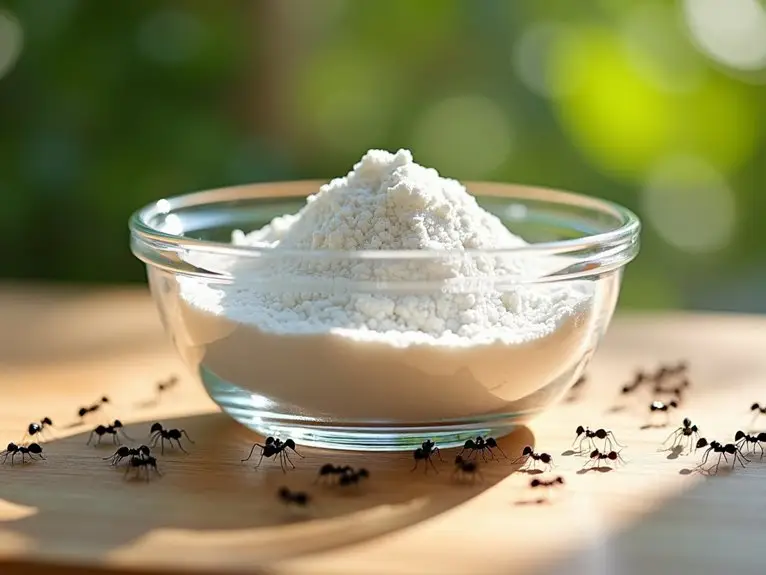
Applying borax indoors requires strategic placement to maximize its effectiveness in eliminating ants. To get started, mix borax with a sweet liquid, such as sugar water or syrup, creating a bait that ants find irresistible.
Use cotton balls soaked in this mixture, positioning them near ant trails or entry points. This way, ants will carry the borax back to their nests, sharing it with their colony, including the queen. It’s important to note that Borax serves as an effective ant killer, outperforming many commercial baits. Additionally, using natural and organic pest control methods can enhance the effectiveness of your pest management efforts.
It’s essential to keep protection in mind. Since borax is toxic when ingested, make sure you place the traps out of reach of pets and children. You might also consider using small jars or tin foil boats to contain the mixture, simplifying cleanup while ensuring protection.
Monitor the area for ant activity over the next 24-48 hours; remember that it may take longer for larger nests to respond.
If you notice many dead ants near the traps, it might indicate that your mixture is too strong. Adjust the formulation accordingly, ensuring that the ants have enough time to return to their nests before dying.
If the ants persist, repeat the application, keeping traps in place for a few days to catch any stragglers.
Applying Borax Outdoors
Borax can be an effective solution for tackling outdoor ant infestations. To maximize its impact, you’ll want to prepare borax bait that attracts ants while ensuring it’s securely placed. Here’s a quick guide on how to create and position your bait:
| Bait Type | Recipe |
|---|---|
| Liquid Bait | Mix 1/2 cup sugar, 2 tsp borax, and 350ml water. |
| Solid Bait | Combine 1 part borax with 3 parts powdered sugar. |
| Placement Tips | Set bait near ant trails or mounds, but avoid direct contact with plants. |
When applying borax outdoors, place your bait close to ant trails and entry points. This increases the chance that ants will find it and carry it back to their colony. If you’re dealing with fire ants, target their mounds for the best results. Use containers like small plastic lids or foil boats to protect your bait from rain. Additionally, it’s important to note that borax must be mixed with attractants to effectively lure ants. Effective pest control requires a thorough understanding of the pest’s behavior and habits.
Remember to exercise caution. Too much borax can harm your plants, and it’s essential to keep it out of reach of pets and children. Since ants that consume the bait can die within 24-48 hours, you might need to reapply the bait over several days or weeks, especially if you’re facing a large colony.
Types of Ants Affected
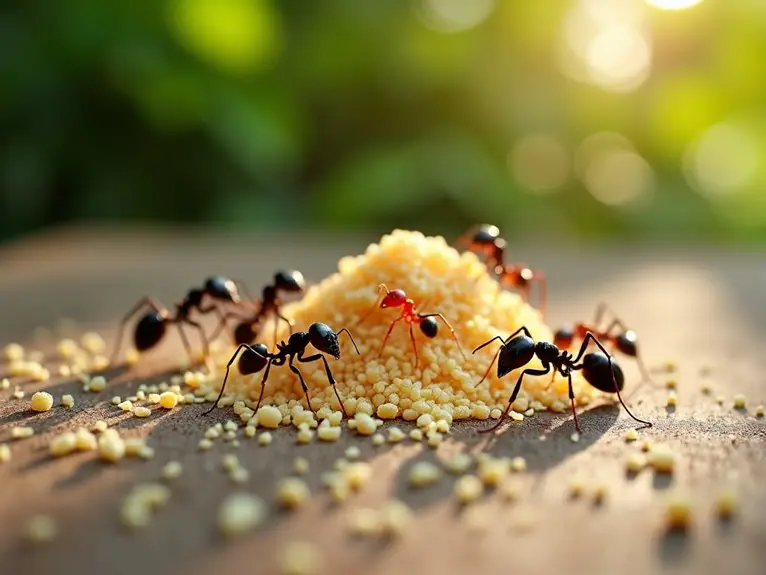
When dealing with ants, it’s essential to understand the types that could be affected by your bait. Dietary preferences play a significant role in how well your chosen solution works, as different ants are drawn to specific food sources. For instance, Borax’s effectiveness as an ant control method is particularly noted because it disrupts the digestive systems of many common ant species.
Universal Ant Toxicity
For many homeowners, dealing with ants can be a frustrating experience, but using borax provides an effective solution for various species. Borax is toxic to most common ant species, including those bothersome household ants that invade your space. It disrupts their exoskeleton, leading to dehydration.
When ants consume a borax-sugar mixture, they carry it back to their nests, sharing it with their colony—this includes the queen. This method is particularly powerful, as it doesn’t distinguish between worker ants and the queen, ensuring the entire colony is eventually wiped out.
The beauty of borax lies in its universal toxicity. It targets a wide range of ant species that follow scent trails into your home. Plus, it doesn’t matter if you’re dealing with sugar-loving ants or protein-attracted ones; you can mix borax with various attractants like honey or peanut butter. Additionally, its slow-acting nature allows the worker ants to spread the borax within their colonies effectively.
The gradual exposure to borax means ants return to their nests, spreading the solution before they die, making it an efficient long-term solution.
Using borax not only tackles your ant problem but also helps you reclaim your space, fostering a sense of belonging in your home.
Dietary Preferences Impact
Understanding the dietary preferences of ants can greatly influence your pest control efforts. Different ant species have unique tastes that you can leverage for effective extermination.
For instance, household ants are drawn to sweet substances like sugar, making sugar-based borax baits highly appealing. Mixing borax with sugar, honey, or syrup can attract these ants, who’ll happily carry the bait back to their colonies. In Florida, common pests like ants are a prevalent issue, making this method particularly relevant.
On the other hand, carpenter ants prefer protein-based foods. If you encounter these pests, try using peanut butter or canned tuna mixed with borax. This approach guarantees the bait reaches the heart of the colony, including the queen. Additionally, the effectiveness of this method can be enhanced by using a Borax and sugar solution when targeting sweet-seeking ants.
By recognizing which ants are invading your space, you can tailor your bait to meet their preferences. Ghost ants and other small species may also respond well to either sugar or protein baits.
To maximize your chances of success, place the baits near ant trails and entry points, and monitor them regularly. Adjusting your bait based on the specific species can considerably enhance the effectiveness of your borax treatment, creating a community-focused solution that benefits everyone.
Long-Term Effects and Maintenance
Effective long-term ant control requires consistent maintenance and monitoring of your chosen solution. Borax-based ant baits can wipe out an entire ant colony within just a few days, but staying vigilant is key. As the ants carry borax back to their colony, it’s crucial to check for new ant activity regularly. If you notice fresh trails, don’t hesitate to reapply the bait, as different colonies may have their own scent markers.
To keep your borax solution effective, store it properly, away from rain and direct sunlight. This guarantees it remains potent for future use. If you’re dealing with persistent infestations, think about combining borax with other natural agents like diatomaceous earth. This can boost your long-term results and provide a more thorough control strategy, especially since borax is toxic to all ant species.
Always prioritize security; keep borax out of the reach of pets and children, and wash your hands after handling it. Label your borax solution clearly to avoid any mix-ups with household items.
It’s also wise to use it in areas where non-target animals can’t ingest it.
Chemical Composition of Borax
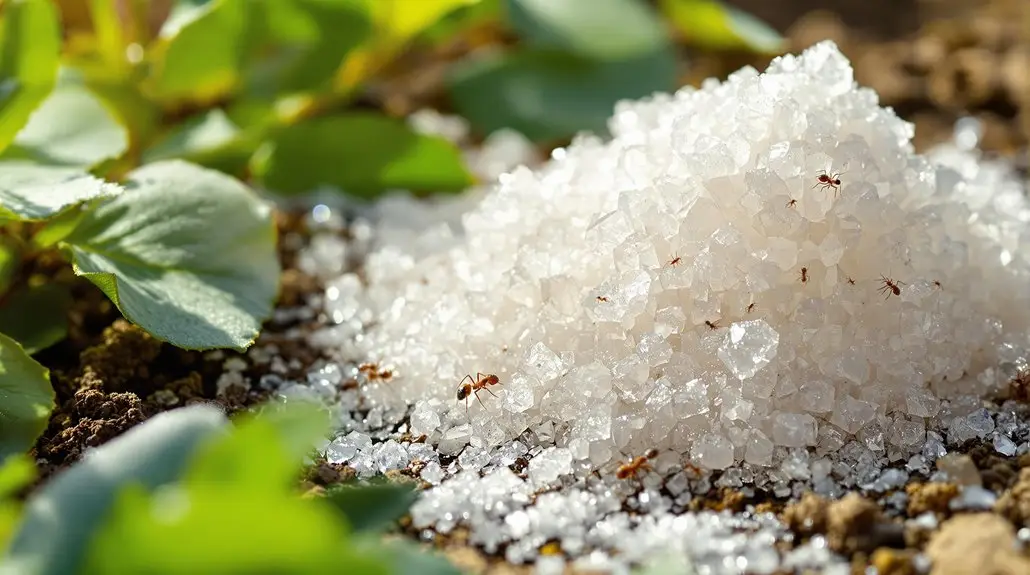
When you look at borax, you’ll find it’s made up of sodium, boron, oxygen, and hydrogen, creating a complex yet effective compound.
Its chemical formula, Na₂B₄O₇·10H₂O, showcases how these elements work together to form a white crystalline solid with unique properties. Borax is a compound of boron, oxygen, and soda, which contributes to its effectiveness in various applications.
Understanding the composition of borax can help you appreciate its stain-fighting power and versatility in dealing with ant problems.
Borax Composition Breakdown
Borax, a versatile compound commonly used for pest control and cleaning, has a fascinating chemical composition that makes it effective in various applications. Understanding its makeup can deepen your appreciation for this natural solution. Borax is also a precursor to boric acid, a common insecticide. Additionally, the use of environmentally friendly solutions in pest management highlights the growing trend of sustainable practices.
Here’s a quick breakdown of Borax’s chemical components:
| Component | Quantity |
|---|---|
| Boron atoms | 4 |
| Oxygen atoms | 17 |
| Sodium atoms | 2 |
| Hydrogen atoms | 20 |
The chemical formula of Borax is Na₂B₄O₇ · 10H₂O, also known as sodium tetraborate decahydrate. This means it has a complex structure that includes the [B4O5(OH)4]²⁻ ion. The unique arrangement features both four-coordinate and three-coordinate boron centers, showcasing its versatility.
Borax naturally occurs in evaporite deposits and dry lake beds, often mined in arid regions like California’s Death Valley. By learning about its elemental and structural composition, you become part of a community that values natural solutions for everyday challenges, like managing bothersome ants!
Sodium Borate Properties
Understanding Borax’s chemical composition paves the way to exploring its properties as sodium borate. This versatile compound, with a molecular formula of Na2B4O7, showcases a unique blend of characteristics that make it useful for various applications, including pest control.
Here are four key properties to evaluate:
- Physical Form: It appears as a white, water-soluble powder or soft, colorless to white crystals.
- Solubility: Sodium borate dissolves easily in water and other solvents, enhancing its effectiveness in solutions.
- Melting Point: It has a high melting point of 741 °C, making it stable under heat.
- Hygroscopic Nature: This compound absorbs moisture from the air, which can affect its performance if not stored properly.
These properties not only highlight sodium borate’s functionality but also underscore its importance in secure, natural pest control solutions.
Mechanism of Action
Disrupting the ant’s digestive system is a key way borax exerts its lethal effects. When ants consume borax, it interferes with their ability to digest food by inhibiting enzyme activity in their digestive tract. Once ingested, borax reacts with stomach acid, releasing boric acid, which is toxic to ants. This disruption leads to starvation and, ultimately, the death of the ants.
The slow-acting nature of borax is advantageous, as worker ants carry it back to their colonies, spreading it to others, including the queen. If the queen ingests borax, her ability to produce viable offspring diminishes, jeopardizing the colony’s future.
Borax also targets the ant’s exoskeleton. Acting as a desiccant, it absorbs the waxy protective layer, leading to dehydration. Its abrasive properties can cause physical damage, further compromising their external protection. This dual mechanism—dehydration and structural damage—ensures their demise.
What’s particularly effective about borax is its indirect transmission. As worker ants carry the contaminated bait throughout the nest, they unintentionally expose hidden members of the colony, including those in hard-to-reach areas. This gradual process helps to eliminate the entire colony over time.
Whether you’re dealing with Argentine ants, odorous house ants, or carpenter ants, adjusting your bait with sugar or protein can cater to their unique preferences. With borax, you’ve got a versatile and effective solution that brings your community together in the fight against unwanted pests.
Environmental Impact of Borax
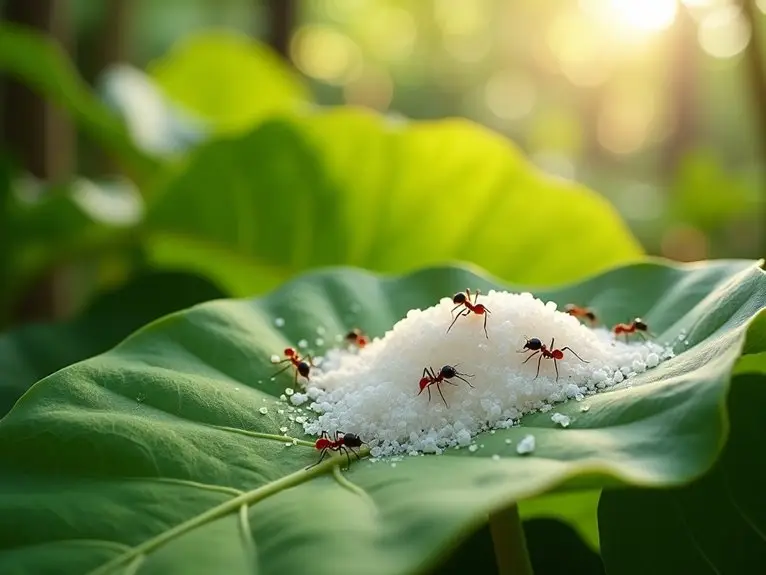
When considering borax as a natural solution for ants, it’s essential to weigh its environmental impact.
While it may seem eco-friendly, borax can pose risks to wildlife and disrupt local ecosystems.
You’ll want to think about these factors before using it in your pest control efforts.
Eco-Friendly Pest Control
Eco-friendly pest control methods aim to minimize harm to both the environment and human health, and borax often comes under scrutiny in this regard. While it’s a popular choice, you should consider the following impacts:
- Toxicity to Insects: Borax is effective against pests, but it disrupts insect metabolism and can affect their reproductive systems.
- Human Health Risks: It can cause skin irritation, nausea, and respiratory issues, particularly with improper use.
- Environmental Persistence: Borax can linger in soil and water, potentially leading to long-term environmental consequences.
- Alternatives Available: Boric acid is often a better choice for pest control due to its higher effectiveness and lower toxicity.
When you think about using borax, weigh these factors carefully.
While it can be part of your pest control arsenal, always prioritize well-being for your family and the planet.
Explore certified green alternatives that align with your eco-friendly values, ensuring you protect both your home and the environment.
Safe for Wildlife
Borax, while effective for pest control, raises important questions about its impact on wildlife and the environment.
You’ll be relieved to know that boron salts naturally occur in low concentrations in most unpolluted waterways and surface soil. While boron is a trace nutrient, its essential biological role isn’t fully understood. At typical use levels, technical boric acid is practically nontoxic to birds, fish, and aquatic invertebrates, making it a more secure choice for your pest control needs.
However, it’s vital to be mindful of high doses, as they can harm aquatic life, particularly for endangered species. The EPA has established guidelines to mitigate these risks, emphasizing limited treatment areas to reduce runoff.
While some non-target plants may be affected, boric acid’s low toxicity allows beneficial insects to thrive.
Alternative Attractants
Ants can be lured away from your home by employing a variety of alternative attractants that cater to their diverse tastes. By using these attractants, you can create an effective bait that draws ants in while delivering the borax they need to control the infestation. Here are some options you can consider:
- Sweet Attractants: Mix 1 part borax with 3 parts sugar, or use honey to create a thick paste. Icing sugar or powdered sugar also works well. Adding warm water helps achieve a syrup-like consistency, making it even more enticing for ants.
- Protein-Based Attractants: If you’re dealing with savory-loving ants, peanut butter can be a game changer. Canned tuna is another excellent choice for outdoor ant control. Mixing borax with these protein-based substances guarantees you’re targeting ants that prefer these flavors.
- Fruit and Compost: Watermelon rinds or sweet, fermented compost materials can attract ants interested in different food sources. Mixing these with borax allows you to cater to their specific preferences.
- Soaked Cotton Balls: You can soak cotton balls in a borax mixture and place them near ant trails. This method is effective for targeting ants while keeping the bait contained and easy to manage.
Using a combination of these attractants will increase your chances of successfully drawing ants away, allowing you to reclaim your space and foster a sense of belonging in your home.
Safety Precautions During Application
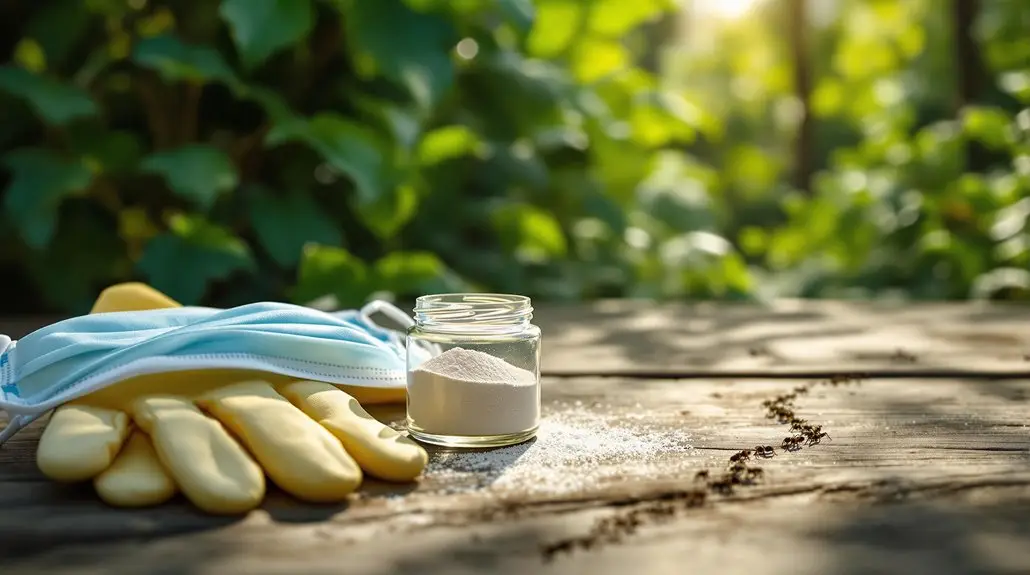
Ensuring security during the application of borax is essential for protecting your family and pets. You want to create a secure environment while effectively dealing with those troublesome ants. Start by keeping the borax mixture out of reach of children and pets. Consider using safety caps on containers, like old prescription bottles, to prevent any accidental access. Clearly label these containers to indicate they contain a hazardous substance, and place the bait in high shelves or secured spots, away from curious hands and paws.
When handling borax, wash your hands thoroughly afterward to avoid any skin irritation. Inhaling borax dust can lead to respiratory issues, so be mindful. Wearing protective gloves while mixing and applying the solution is a smart move. Remember to keep borax away from food and water sources to prevent contamination.
For application, position the borax bait near ant trails but shield it from rain and direct sunlight. Use disposable containers or cotton balls to make disposal easier and minimize mess. Monitor the bait regularly and replenish it as needed. A little goes a long way, so use small amounts to let the ants carry it back to their colony.
Lastly, be cautious about environmental impacts. Avoid using borax near gardens or plants where it might harm beneficial insects. With these safety precautions, you can effectively manage your ant problem while ensuring a secure space for your loved ones.
Frequently Asked Questions
Is Borax Safe for Use Around Food?
Borax isn’t secure for use around food. You might think it’s a handy solution for various household issues, but it poses serious health risks, especially if ingested.
It’s banned as a food additive in many countries, including the U.S., due to its potential to cause digestive problems and other severe health issues.
To keep your home secure, stick to alternatives that won’t compromise your family’s health. Your loved ones deserve better!
How Long Does It Take to See Results?
Did you know that you can see a noticeable reduction in ant activity within just 24 to 48 hours?
When you set up effective bait, you’ll begin to notice changes quickly.
Patience is key, though—complete eradication can take a few weeks to months.
Can Borax Harm Beneficial Insects?
Yes, borax can harm beneficial insects. While it’s generally nontoxic to many, it can still pose risks if they come in contact with it or ingest it during grooming.
To protect these helpful critters, you should apply borax carefully, targeting only pest areas and avoiding times when beneficial insects are active.
What Should I Do if Pets Ingest Borax?
If your pet’s gotten into borax, it’s like a storm cloud rolling in—urgent action is needed.
Rinse your pet’s mouth and any skin that touched it, and call your vet right away.
Don’t make them vomit unless your vet says so. Keep an eye on them for symptoms like vomiting or lethargy.
The sooner you act, the better their chances of a swift recovery, so don’t hesitate!
Is Borax Effective Against Other Pests?
Yes, borax can be effective against various pests like cockroaches and termites, but its efficiency varies.
For cockroaches, mixing borax with sugary foods increases the chance they’ll ingest it. However, it’s less effective against termites, as they don’t consume it in harmful amounts.
When using borax, always prioritize protection, especially around pets and kids.
Conclusion
In summary, using borax is a smart, natural way to tackle those annoying ants invading your space. By understanding how it works and applying it correctly, you can reclaim your home and yard without resorting to harsh chemicals. Just remember, it’s always better to be cautious than sorry—take those necessary precautions while you’re at it. With a little patience and the right approach, you’ll be saying goodbye to ants in no time!
For a more comprehensive solution, consider partnering with NaturePest Holistic Pest Control. Our experts can guide you in effectively using borates and provide additional holistic strategies to keep your home pest-free. Don’t let ants take over your space—contact NaturePest today and take the first step toward a naturally pest-free environment!

